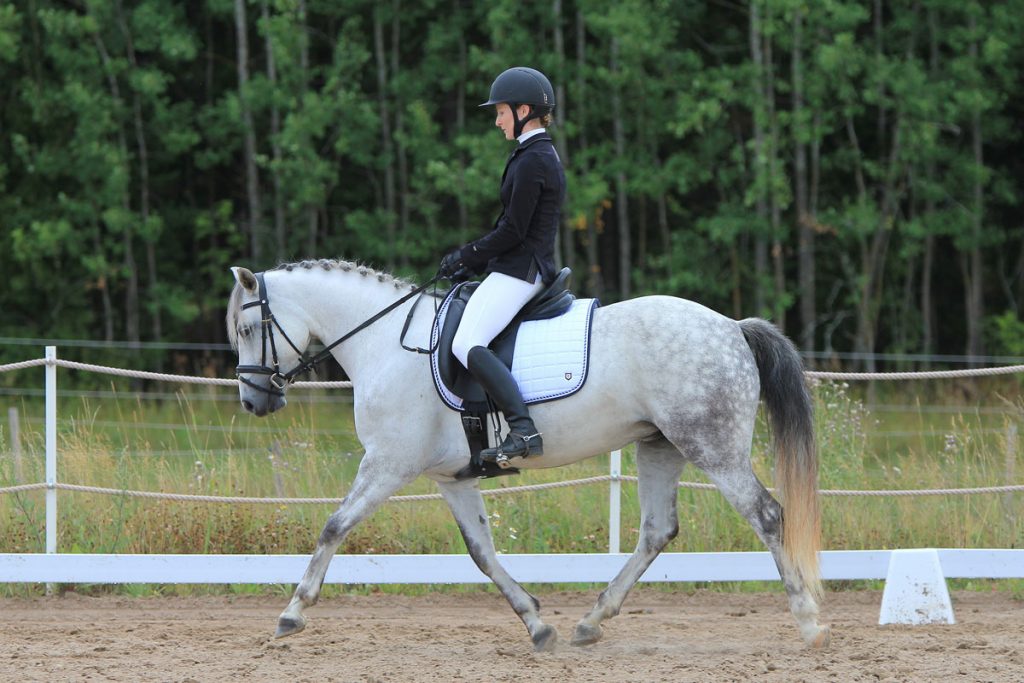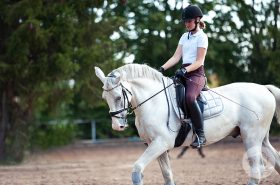Become a better rider by using this helpful aid.
Half halts are used in abundance within the dressage world, but the reality is all riding disciplines can benefit from their application. In simple terms, a half halt is a specific riding aid. This tool can transform your horse into an elegant and willing partner. Unfortunately, the aid is often used incorrectly. It can also cause quite a bit of confusion among riders.
Let’s see if I can shed some light onto how important the half halt is and the correct usage!
What is a Half Halt?
The seat, hands, and legs coordinate together to balance and hold the attention of the horse. This barely visible aid shifts the weight from the forehand to the hindquarters in preparation for the next maneuver or transition.
The Purpose of a Half Halt
As mentioned, the half halt prepares your horse for their next command. It gets them thinking! Whether you’re about to transition, ride through a turn, or jump, this aid will gain your horse’s focus beforehand.
It can also establish a change of pace. You can use it to transition between the different gaits or to change the length of stride within the gait. The half halt is often used when trying to collect the horse in the walk, trot, or canter.
Furthermore, the half halt creates lightness of the forehand and engages the hind quarters. This helps your horse to achieve overall balance. It’s especially helpful for the horse that is heavy on the bit.
How to Apply the Half Halt
A rider must first know how to give basic aids and how to sit properly. The half halt is a combination of three aids. Think- create the forward energy, control or contain that energy, and then release it.
First, the rider will need to drive the horse forward. This comes from an active and engaged seat. The aid will be nearly invisible when coming from an accomplished rider. Swinging hips can encourage the forward movement, but if that fails use your legs or a whip.
Your next aid will be to bring the horse back. This can be done by sitting deep and tall in the saddle. Allow your hands to make contact with the horse’s mouth. It’s essential you no longer drive your horse forward. You must keep supple wrists though. In the beginning, it may be necessary to use more contact with your hands to encourage your horse back onto their haunches.
Complete the half halt by driving your horse out again with forward energy.
Word to the Wise
There are a few things you should avoid doing! The first is to pull or brace on the reins for an extended period of time. The half halt can be accomplished in a single stride. You don’t want your horse to start leaning on your hands. Furthermore, you’ll want to avoid relying on the reins. Your legs and seat create most of this aid.
Beginner riders often struggle with position and separating their aids. You can confuse your horse if you hold the contact and drive your horse forward with your seat at the same time. Other times, the upper body will collapse and cause your horse to slow and lose momentum. And too much seat can make the horse hollow. You must learn to feel your horse and anticipate how much seat, hand, and leg to use.
Timing can also cause trouble for some. It can be hard to describe the ideal timing, but when you feel your horse needs to be rebalanced that is a good indicator.
The half halt is a valuable tool. It can educate the young horse and influence the experienced one. No matter what type of riding you do, use these principles to get better communication with your horse under saddle.
**
Emily Fought discovered her passion for horses early on in life. When she isn’t writing about them, you can find her in the barn riding. Although Emily’s background is in dressage, she enjoys cross-training and is an avid trail rider. She resides in Northwestern Pennsylvania with her husband and small dog. Together, they own and operate Humblewood Farm.





